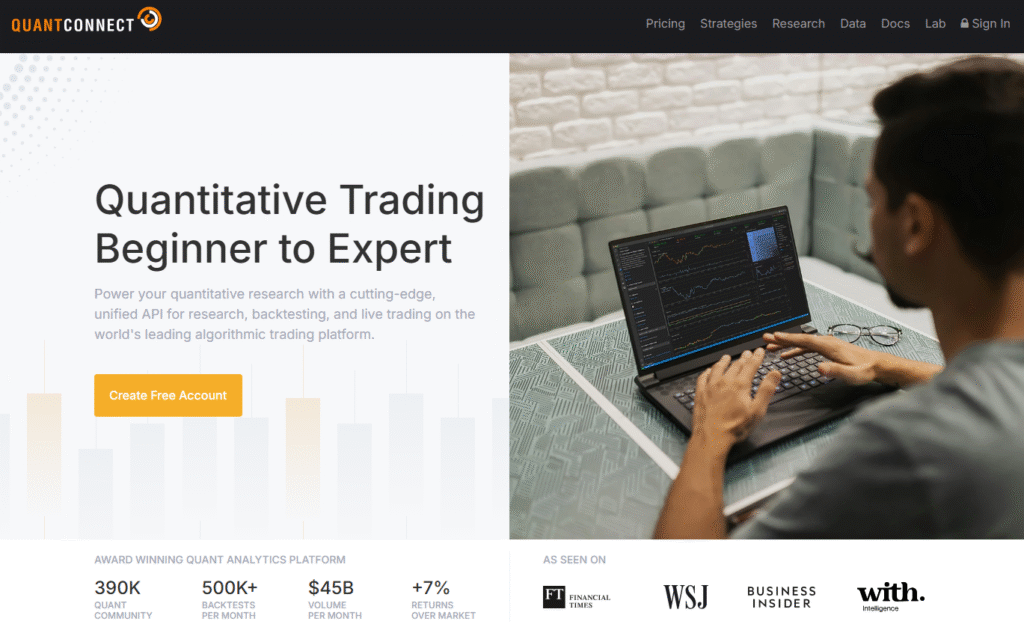In the rapidly evolving landscape of financial markets, the competition between AI-driven trading strategies and traditional human methods is intensifying. As we move through 2025, artificial intelligence has revolutionized the execution, analysis, and optimization of trades, putting the intuition and expertise of human traders to the test.
But who comes out on top? Let’s compare AI-driven approaches, like algorithmic trading and sentiment analysis, with traditional methods to see which reigns supreme—and how tools like QuantConnect can empower traders to leverage cutting-edge technology.
The Rise of AI-Driven Trading
AI-driven trading uses advanced algorithms, machine learning, and data analytics to make trading decisions. Unlike human traders, who rely on intuition, research, and experience, AI systems process vast datasets in real time, identifying patterns and opportunities that might escape the human eye. Two frequently-mentioned AI strategies include algorithmic trading and sentiment analysis, each presenting distinct benefits.
Algorithmic Trading: Speed and Precision
Algorithmic trading, or algo-trading, involves pre-programmed instructions that execute trades based on specific criteria, such as price, volume, or timing. By 2025, AI-enhanced algorithms have reached remarkable levels of sophistication, utilizing machine learning to adjust to market conditions in real-time. For example, an AI algorithm can analyze historical price data, economic indicators, and even geopolitical events to predict stock movements with high accuracy.
Imagine a period where the stock price dropped or even plunged, for whatever is the reason. A human trader may hesitate, considering emotional influences or waiting for validation from news outlets. An AI algorithm, however, can instantly detect the trend, execute a sell order, and minimize losses—all within milliseconds. Platforms like QuantConnect make this accessible by offering a cloud-based environment where traders can design, backtest, and deploy algorithms without deep coding expertise.
Sentiment Analysis: Reading the Market’s Mood
Another powerful AI tool is sentiment analysis, which scans social media, news articles, and other textual data to gauge market sentiment. In 2025, platforms like X provide a goldmine of real-time data, where AI can analyze millions of posts to predict how public opinion might influence stock or crypto prices. For example, a rise in positive X posts regarding a new tech product could indicate a possible stock surge for the company, leading AI to purchase shares before the trend is widely recognized.
Human traders might attempt similar analysis by reading news or following influencers, but they can’t match AI’s ability to process thousands of data points simultaneously. Tools such as QuantConnect incorporate sentiment analysis into trading strategies, enabling users to take advantage of these insights with ease.

Traditional Trading: The Human Edge
Despite AI’s advancements, human traders bring unique strengths to the table. Traditional trading often relies on intuition, emotional intelligence, and contextual awareness, allowing humans to handle complex or unpredictable situations where AI may struggle.
Intuition and Experience
Experienced traders rely on years of market observation to make decisions that algorithms might overlook. For instance, an experienced trader might perceive that a company’s stock is overpriced due to industry trends or changes in management—elements that might not yet be captured in the data. This intuition can lead to bold moves, like shorting a stock before a major correction, which AI might miss if the data doesn’t align perfectly.
Flexibility in Uncharted Waters
Humans excel in situations where historical data is scarce or unreliable, such as during unprecedented market events. The 2020 pandemic crash, for instance, caught many algorithms off guard, as they lacked prior data on such a global disruption. Human traders, however, could adapt by factoring in qualitative information, like government stimulus announcements, to make informed decisions.
AI vs. Human: Strengths and Weaknesses
Let’s break down the key differences:
Speed and Efficiency: AI can execute trades in mere milliseconds, significantly surpassing human response times which humans just cannot keep pace with. It can monitor multiple markets simultaneously, ensuring no opportunity is missed.
Data Processing: AI analyzes vast datasets—price histories, economic reports, social media trends—while humans are limited by time and cognitive capacity.
Emotion: Humans are prone to fear, greed, or hesitation, which can lead to impulsive or delayed decisions. AI maintains objectivity, adhering strictly to its programmed logic.
Adaptability: Humans can interpret nuanced events or make judgment calls in ambiguous situations, while AI relies on historical patterns and may struggle with “black swan” events.
Scalability: AI can manage thousands of trades across portfolios, while humans are constrained by time and attention.
Who Wins in 2025?
The answer isn’t black-and-white. AI-powered trading thrives in fast-paced, data-intensive settings such as day trading or cryptocurrency markets, where both speed, analysis, as well as accuracy are essential. For example, in 2025, AI algorithms dominate forex markets, executing thousands of micro-trades daily to exploit tiny price fluctuations. Platforms like QuantConnect enable retail traders to tap into this potential, providing ready-made algorithms and backtesting tools to level the playing field against institutional investors.
However, human traders still shine in long-term investing or niche markets where qualitative factors matter. A hedge fund manager might outperform AI by anticipating a regulatory change based on insider knowledge or industry connections—insights AI can’t yet replicate. The most successful traders in 2025 combine both approaches: using AI for data analysis and execution while applying human judgment for strategic decisions.

Leveraging AI with QuantConnect
With technological advancement, platforms available for professional trading houses/hedge funds are no longer exclusive. For retail traders looking to bridge the gap, platforms like QuantConnect are game-changers.
QuantConnect features an open-source, cloud-based environment where users can create and evaluate AI-driven trading strategies without needing advanced programming knowledge. Its community-driven library includes pre-built algorithms, from momentum-based strategies to sentiment-driven models, making it accessible for beginners and pros alike. With the right platform, you can start backtesting strategies with historical data and optimizing your trades before risking real capital.
For instance, a user on QuantConnect might develop an algorithm that merges sentiment analysis from X posts with technical indicators such as moving averages. The platform’s drag-and-drop interface and Python-based coding options make it easy to customize strategies, even for those with minimal tech experience. For instance, a user on QuantConnect might develop an algorithm that merges sentiment analysis from X posts with technical indicators such as moving averages. Additionally, its integration with brokers like Interactive Brokers guarantees smooth trade execution.
The Future of Trading in 2025
As AI continues to evolve, the gap between human and machine traders narrows. In 2025, the traders who excel the most are those who adopt a hybrid strategy—leveraging AI tools such as QuantConnect for speed and data analysis while employing human intuition for overarching decisions. Whether you’re a beginner or a seasoned investor, platforms like QuantConnect democratize access to AI trading, leveling the playing field.
So, who wins in 2025? It’s not AI or humans—it’s the traders who combine the best of both worlds. Start exploring AI-driven trading today and see how technology can transform your portfolio.

